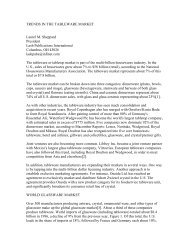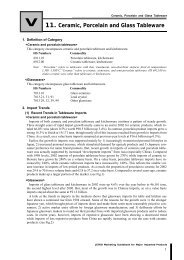Appendices to CBI Export Planner - crecer
Appendices to CBI Export Planner - crecer
Appendices to CBI Export Planner - crecer
You also want an ePaper? Increase the reach of your titles
YUMPU automatically turns print PDFs into web optimized ePapers that Google loves.
<strong>CBI</strong> <strong>Export</strong> <strong>Planner</strong>d. If your organisation does not (yet) have a good financial information system on theelements which constitute your cost-price, you should develop such a systemimmediately. Without it, you will never be able <strong>to</strong> do a good exporting job.Methods for market pricingIf your primary aim in the target market is <strong>to</strong> offer your products at a price-level that doesnot exceed that of your competi<strong>to</strong>rs, your importer will be the first one <strong>to</strong> tell you that.Actually, you should try <strong>to</strong> price slightly lower, some 15% if possible, particularly whenentering the market. This is called Penetration Pricing: trying <strong>to</strong> gain the cus<strong>to</strong>mer’spreference because your price is irresistibly low compared <strong>to</strong> your product quality.The reverse policy is called Skimming, but that will only be used when offering a uniqueproduct with obvious cus<strong>to</strong>mer benefits - and unfortunately only few exporters can offersuch. a product.You will probably try <strong>to</strong> apply the Penetration Pricing method. The Japanese car makersused it very successfully. Be careful: don’t price it <strong>to</strong>o low, as not <strong>to</strong> create suspicion inthe minds of the prospective buyers.What is more, you may raise the suspicion that you are ‘dumping’, offering your goodsbelow cost price. That is not only foolish but also illegal, invariably leading <strong>to</strong> ‘retaliateaction’ from your competi<strong>to</strong>rs who will be quick <strong>to</strong> notify the governmental taxinspec<strong>to</strong>rs.Try <strong>to</strong> find a balance between the quality and the price of your product. In fact youshould try <strong>to</strong> price it at the “perceived value level”. Market research will tell you howconsumers perceive that level <strong>to</strong> be. A penetration price will probably lie somewherebetween 5 and 20% below the current price.Never confuse the buyers. Try <strong>to</strong> create stability and reliability in your pricing as well.Your importer will judge your performance by it.Having gained a certain foothold in the target market, you gradually may want <strong>to</strong>increase your profit by increasing your price. That is logical, as long as the cus<strong>to</strong>meraccepts it. That goes for your trading partner <strong>to</strong>o. He has a vital task in your price-settingpolicy.How do you know if the cus<strong>to</strong>mer will accept that price-increase? That depends upon the“Price-elasticity of the demand”.Essentially, price-elasticity describes how much the price can be changed beforecus<strong>to</strong>mers begin <strong>to</strong> react by buying less when the price is increased or by buying more ifthe price is decreased.Convenience goods (like many packaged staple foods) do not meet much reaction whenprices increase moderately. Consumers will buy anyway. Shopping goods (moreexpensive consumer items) receive a stronger reaction, because the buyers startcomparing the product with other brands or substitutes <strong>to</strong> satisfy their needs. Industrialgoods meet even less reactions, unless the buyers can choose from a multitude ofsuppliers - and drop you when they can buy it a dime cheaper.44 III - The export marketing mix





